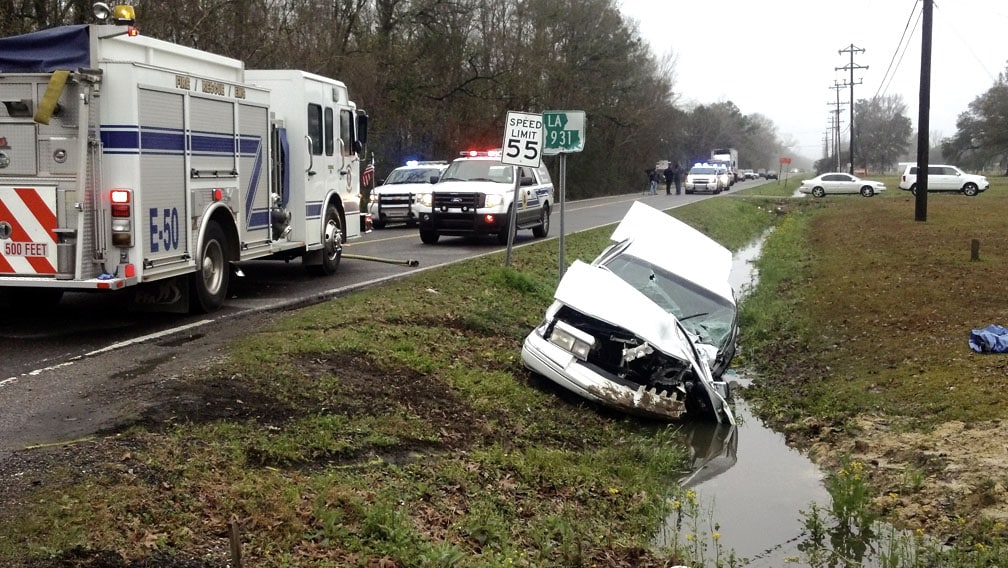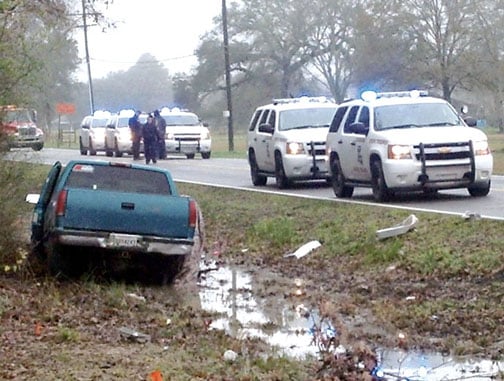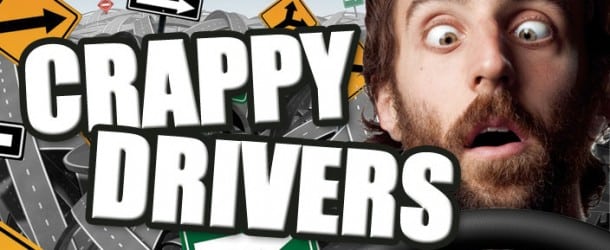They Annoy You. They Terrify You. What Makes Some Local Drivers Do Such Dumb And Dangerous Things? • By Brad Goins
Louisiana driving behaviors have been a big topic in area news lately.
It all started on Dec. 16, when a study released by CarInsurance Comparison.com reported that among the 50 states, Louisiana had the worst drivers.
Car Insurance Comparison is a Seattle-based company owned by a financial planner who lives in the city. All I know about the company is what can be learned from its web site. One can’t tell whether it is any more or less qualified than a hundred other companies to release a survey of which states have the worst driving habits.
What is certain is that various companies and organizations do release lists on the topic from time to time. And if they’re sufficiently well promoted, the lists are widely reported and discussed by the media.
The American Press mentioned the Car Insurance Comparison list in a Dec. 22 editorial that referred to what’s probably more valuable information: a forthcoming study by LSU engineers on the dangers posed by the use of cell phones by drivers.
A day earlier, the Press had reported, in a front-page story, “LC repeats as state leader in seatbelt usage.” This finding, which was announced by state police Troop D, was based on observations of 58,000 Louisiana drivers.
So … findings and lists don’t always line up. What probably makes a greater impact than lists on most area drivers is the degree to which they concur with a statement of exasperation I’ve heard before: “People around here don’t know how to drive.”
Is that the case? Are drivers in Southwest Louisiana especially bad ones? Are they really worse than drivers in Houston or Atlanta?
State Farm insurance agent Dave McCarty provides some strong evidence that something is wrong with the state’s driving performance overall. He says Louisiana has the highest auto insurance rates in the country.
Lack Of Attention
If there’s some sort of problem here, what is it?
“The main reason we see [for bad driving in the area] is inattention,” says McCarty.
“Part of that is cell phones and texting … It’s sad to see somebody going down the interstate at 80 texting. You see people texting at lights.”
Such behavior, says Corp. Scott Dougherty of the Lake Charles Police Dept., is “more prevalent now because everybody’s got something extra.” He’s talking about “personal electronic devices,” which he says cause an “unknown percentage” of driving problems.
Like McCarty, he selects texting for special attention. “It’s adults too,” he says. “It’s a horrible epidemic. That text message — it can wait till the next parking lot.”
Dougherty says the problems don’t stop just because the personal devices are hands-free. He notes that the people talking to drivers “keep talking … regardless of what happens” on the road. The person who’s talking to the driver usually won’t know when the driver’s about to enter a stressful, complex or tricky traffic situation. In such a situation, the voice on the other end of the line is just one more dangerous distraction.
Let’s return to that big notion of driver inattention, of which misuse of personal objects is just a part. A bigger problem than the use of communication devices while driving is that of drivers who are simply “not concentrating” on the task of driving in general, says McCarty.
Dougherty breaks down inattentive driving and closely related careless forms of driving into three kinds of driving behavior:
“Carelessness or lack of concern about your driving habits,”
“Lack of knowledge about what you’re doing,” and
“The age-old tradition of just not paying attention.”
Winding Up In The Ditch
Drivers who fall into the careless category include those who reach down or around to get objects in the floor or back seat, change radio stations while driving or look around when they should be attending to traffic. “When you reach,” says McCarty, “it turns your shoulders; it automatically turns the steering wheel.
“If you drop something, pull over or wait” to pick it up later, he advises.
Another instance of carelessness, he says, is “following too closely,” which, of course, is the frequent cause of rear ending.
Drivers often are “not attentive enough” when they change lanes. They don’t watch lights closely and sometimes aren’t aware that a light has changed color.
It’s common, says McCarty, for “both parties [at a collision at a light to] swear they had a green light.” The situation is often complicated by the fact that “there are no witnesses.”
“They weren’t watching that light,” says McCarty. “[They] weren’t looking. [They] were daydreaming.”
Doughtery’s language about problem behaviors at stop signs and lights is very similar; he says the problems arise because drivers are “not paying attention.”
McCarty points out that when a driver looks to one side [for instance, to look at or talk to a passenger] for two to three seconds, the car typically travels 50-60 feet during the period. “You look up, there [another car] is.”
In some parts of the country, drivers get a little break from inattentive driving because they can, if necessary, leave the road and keep travelling on a flat surface, such as a field. Not so in Louisiana.
“We have a lot of ditches on the sides of our roads” in Louisiana, says McCarty. “Inattentive driving will put you in the ditch.”
Although they come from entirely different fields, McCarty and Dougherty offer the same solutions for these problems of driving without attention to detail. As Dougherty puts it, “Concentrate on your surroundings. Be aware.”
Seatbelts And Rollovers
If no seat belt has been fastened around a passenger’s body, at the time of an impact or sudden stop, the body will continue to travel at the same speed as the car in which the passenger was riding.
One obvious example of a potential problem here is a situation in which a passenger could be thrown into a windshield or metallic structure in the car.
Another obvious potential for disaster for the unrestrained driver or passenger is roll overs, which are all the more likely in Louisiana because of the prevalence of ditches.
State Police Sergeant James Anderson, who handles public information for 34 parishes in West Louisiana, notes the prevalence of pick-up trucks in Southwest Louisiana, and adds that “pick-up trucks is the biggest area in terms of seat belt compliance” in the area.
“There is a misperception among many pick-up truck drivers that they’re safe without seat beats,” says Anderson. The misperception arises from a sense that the truck is, obviously, a very large vehicle.
But Anderson sees accidents in which pick-up drivers who aren’t strapped in are thrown from the truck only to have the vehicle roll over them.
A “vehicle is a shell of protection,” says McCarty. “Outside you don’t have any protection.” As a veteran insurance man, McCarty can tell stories about incidents in which two people were thrown from a vehicle: one died, the other was hardly injured.
A seat belt will not keep all drivers safe in all situations. What it will do, says Anderson, is “greatly enhance your odds of surviving” a crash.
Seat belt use is “something we’re working on [in the State Police],” says Anderson. Part of the work was issuing more than 8,000 tickets to Louisiana drivers in 2013 for failure to buckle up.
“If we can get the word out that seat belts save lives, we don’t have to write a bunch of tickets,” says Anderson. Using seat belts, he says, “is the single most effective thing someone can do to keep themselves safe in a crash.”
Both speeding and drunken driving are problems that can be compounded by failure to use seat belts. I talked with Anderson the first Monday morning after Christmas. He’d spent the preceding weekend clocking excessive speeding, including one driver who’d entered Sulphur at a speed of more than 98 mph.
He also reported on a Christmas Eve incident regarding a driver going at more than 100 mph on Highway 27. The driver, who wasn’t wearing a seat belt, was, at some point, ejected from his vehicle. His body was found 200 feet from the car. Since toxicology reports hadn’t yet been filed, it wasn’t known whether impairment was one of the factors contributing to this driving catastrophe.
While drinking then driving is still a problem, McCarty thinks the problem is lessening, probably due to increased awareness of law enforcement crack-downs on DWI.
That would be a good development, of course. But Louisiana may have further to go in this area than other states. Anderson feels that the state “generally has a higher problem with impairment” than other states. By impairment, he means driving either while drunk or while under the effects of drugs, and in particular, prescription drugs that have been misused.
“We’re not against people drinking,” says Anderson. “We just want to dissuade people from getting behind the wheel.”
The state police’s relentless focus on two basic driver behaviors — driving while impaired and failing to wear seatbelts — may create a picture of problem driving that is less diverse than some would like to see. But, says Anderson, “We [will] beat that same drum,” until the Louisiana gets these two fundamental behaviors down.
Pet Peeves
Doughtery polled his fellow traffic patrol officers to discover their Top 5 “pet peeves” about problem drivers. The list surprised me. I wouldn’t have guessed a single item on it.
Finishing at No. 1 on the list of pet peeves was those who drive in the left lane of the interstate when they’re not passing. Dougherty notes that on occasion, people who do this call police to complain that they’re being tailgated on the interstate. The responding officer’s first question is likely to be “What lane are you in?” If the answer is “the left,” the driver will be told that the simple solution is to move to the right.
The inclination of some drivers to opt for the left-hand lane regardless of the situation is a very deep-seated thing. For years, the Highway Regulatory Act required that drivers move to the right lane when those behind them wanted to pass. That law wasn’t doing the trick, so in August, 2009, Louisiana regulations were stiffened to require that interstate drivers keep to the right unless they’re going to try to pass.
For this area, part of pet peeve No. 1 is the tendency of drivers of large trucks to use the left-hand lane on the I-10 bridge. Dougherty notes that two signs on the bridge prohibit such usage.
No. 2 on the list is drivers who don’t yield — especially when they’re preparing to go on the interstate. “People go on the interstate and think traffic has to move over for them,” says Dougherty.
No. 3 is drivers who use a left-turn-only lane as a “lane of travel.” The law prohibits drivers from travelling more than 200 feet in a left-hand turn lane.
No. 4 is drivers who don’t move to the right when they hear the siren of an ambulance, fire truck or police vehicle.
The attempt to get out of the way of an emergency vehicle by making a left turn is especially dangerous. Often, says Dougherty, drivers of emergency vehicles are simply trying to get around the vehicles on the road. “A left turn may cause a collision” when an emergency vehicle driver veers around a cluster of immobile cars only to see a turning car shoot into his line of vision.
Completing the list at No. 5 is the group of people who drive on the shoulder — for instance, to try to go around backed-up traffic or people who are turning. As one would expect, collisions between drivers who are foolishly driving on a shoulder and those who are making perfectly legal turns can be nasty ones.
Taking Driving Seriously
As for findings that Louisiana drivers are especially poor, Dougherty feels there are places in Louisiana where the driving is worse than in the Lake Area. “We’re pretty average,” he says. “In Baton Rouge, motorcycle officers get clipped quite a bit.”
Of course, greater Lake Charles is becoming a bit more like a big city — at least in terms of its growing infrastructure and new housing and retail developments. “Lake Charles is under a very large expansion of the infrastructure,” says Dougherty. He says drivers can prepare for the changes by being patient, planning alternative routes and leaving for their destinations earlier than usual.
Area drivers who manage to avoid the frequent, widespread roadwork will have to continue to work to fight lack of attention. People who become comfortable driving the same vehicle on the same streets with the same passengers can be lulled into an illusion of safety. “We get so comfortable we become complacent,” says Dougherty. “A car weighs a lot. It can do a lot of damage.”
“I take driving very seriously,” he says. “I make my kids be quiet … People need to take driving more seriously. They’re slacking.”
















Comments are closed.